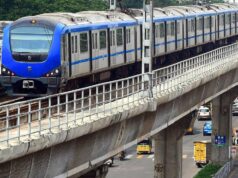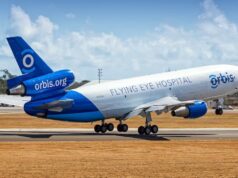After all five project phases are finished, the Navi Mumbai International Airport (NMIA) will have two runways and four terminals, and it would be able to handle 90 million passengers a year. However, there will only be one runway in phase one.
By April 17, 2025, the Navi Mumbai International Airport (NMIA) is expected to open, representing a major advancement in India’s aviation infrastructure. In order to receive the aerodrome license from the Directorate General of Civil Aviation (DGCA), an IndiGo A320 aircraft had to successfully land on Sunday at runway 08/26 of the airport that is still under construction.
The CEO of Adani Airport Holdings Ltd (AAHL), Arun Bansal, discussed the project’s ambitious timeframe in a statement following the trial landing. “On April 17, we hope to open the airport for business. The second half of May is when domestic operations are anticipated to start, and by the end of July, international flights would follow,” Bansal stated.
In NMIA, the City and Industrial Development Corporation of Maharashtra (CIDCO) owns 26% of the company, while Adani Airport Holdings Ltd. (AAHL) owns 74%. The facility, which cost ₹16,700 crore to build, is intended to ease the strain on Mumbai Airport, which is already overcrowded, and meet the growing demand for air travel in the area.
After all five project phases are finished, the airport will have two runways and four terminals, and it will be able to handle 90 million people a year. However, phase one will only include one runway and a terminal that can handle 20 million passengers annually.
A crucial step in NMIA’s validation procedure was completed with the successful trial flight. Two Crash Fire Tenders (CFTs) ceremoniously gave the IndiGo plane a water salute upon its arrival at 1:32 p.m. This milestone prepares the way for DGCA approval while validating the Instrument Approach Procedures.
Bansal said, “Today is a historic day for Navi Mumbai International Airport.” “With safety as our top priority, the validation flight moves us closer to operational readiness.” To ensure accuracy in landing operations, NMIA had previously finished flight calibration of the Instrument Landing System (ILS) and Precision Approach Path Indicator (PAPI) in advance of this stage.
In February 2018, Prime Minister Narendra Modi lay the NMIA’s foundation stone. When it opens, it will be a compliment to the current Mumbai Airport, which, despite having only one runway, now handles about 50 million passengers a year.
“With the current demand in the Mumbai region exceeding 60-65 million passengers annually, NMIA will capture the unmet growth in air traffic,” Bansal said. He did concede, though, that because the first terminal can only handle 20 million people, terminal capacity would initially continue to be a bottleneck.
The second terminal’s construction is currently under way and is expected to be finished by March 2028, adding 30 million passengers a year. The airport plans to handle 10–12 million passengers a year by December 2025, increasing to 20 million by the middle of 2026.
Although airlines are keen to migrate their operations to NMIA, Bansal said it is unlikely that they will completely abandon the current Mumbai Airport. “Most domestic airlines are large enough to split their operations between the two airports, ensuring capacity utilization across the Mumbai Metropolitan Region,” he said. To ensure operational efficiency, each runway at NMIA will be able to handle 50 air traffic movements per hour.
It is anticipated that the airport will revolutionize the area by easing Mumbai Airport’s traffic and promoting trade and tourism.







